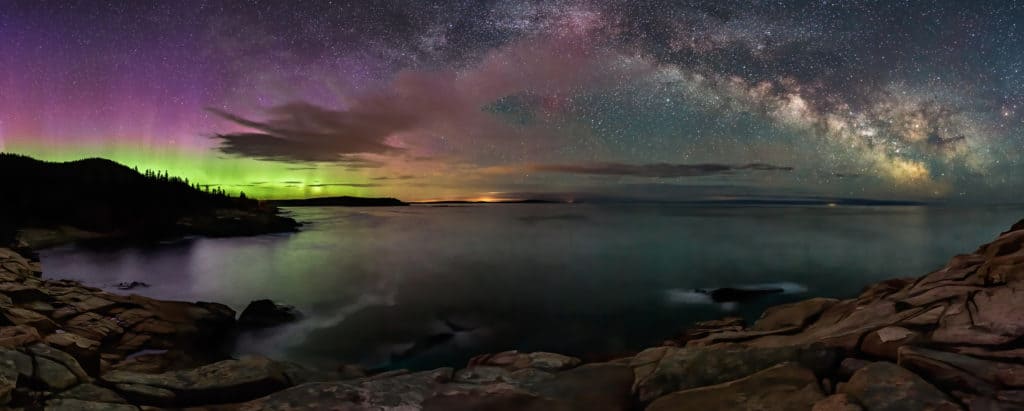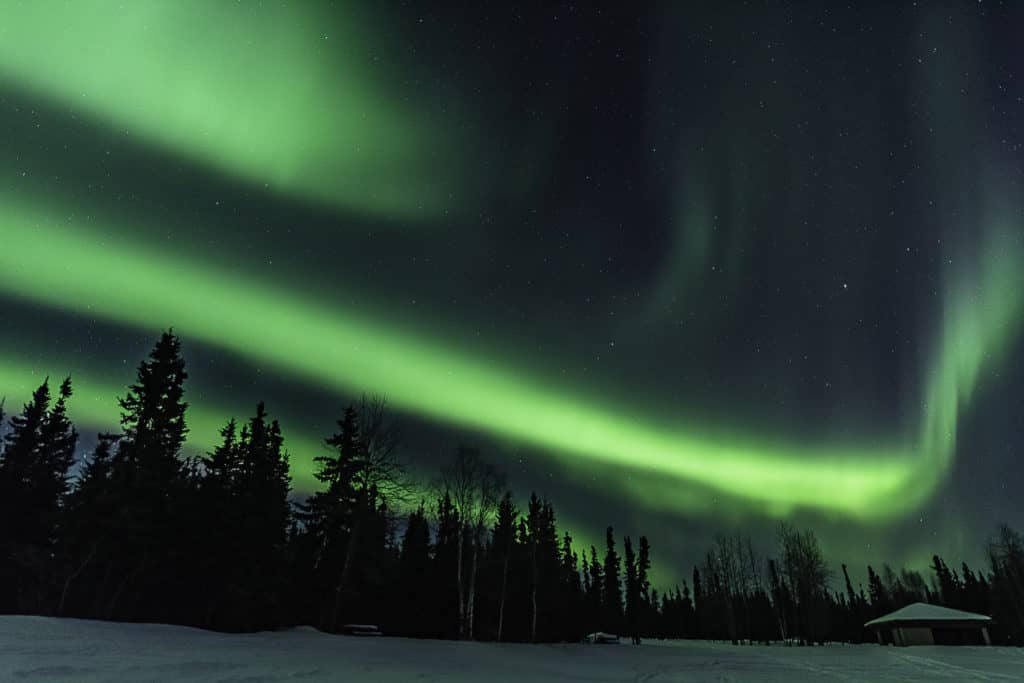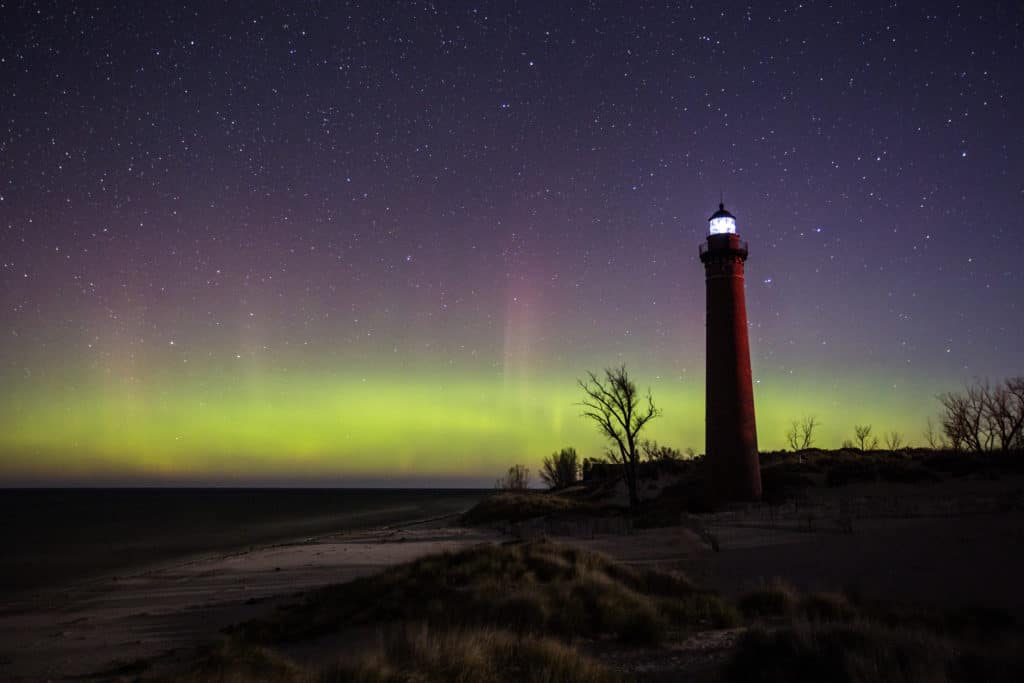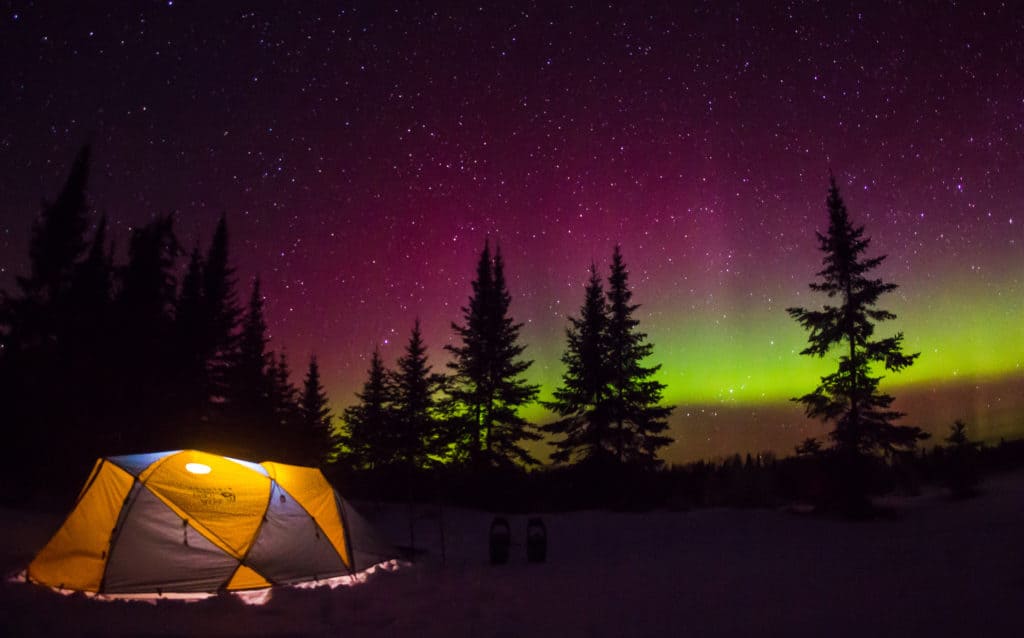Places to see the Northern Lights in Maine, Pennsylvania, Alaska, Michigan, Minnesota and Idaho.
Imagine broad streaks of green, red, blue and purple lights dancing to the rhythms of silent celestial melodies across the night sky. Such is the awe-inspiring light show known as the Aurora Borealis or Northern Lights that greets visitors fortunate enough to find themselves in a high-latitude spot where manmade lights are absent and a solar storm has scattered gas particles into earth’s magnetic field.
While various nations near the Arctic Circle such as Norway, Iceland and Canada have become known as ideal Northern Lights destinations, the U.S. is home to the extraordinary phenomenon, too. In fact, several states have just the right northern location and deep dark skies to ‘stage’ some of the best aurora borealis shows on earth.
Amazing Northern Lights displays occur frequently in the below states, though there’s never a guarantee you’ll see them. Plan on spending 5-7 days on your quest in any given destination and before venturing out, be sure to check if space and weather conditions are conducive to the lights’ appearance. By utilizing dedicated trackers (see Resources section below) and choosing your time and place on the basis of real data, you’ll vastly improve your chances of seeing the lights.
Maine – Aroostook National Wildlife Refuge

To view the Northern Lights on the East Coast, head to the 7,750-acre Aroostook National Wildlife Refuge located on the border between the U.S. and New Brunswick, Canada (about 155 miles north of Bangor). The rural locale (it’s the northernmost National Wildlife Refuge in the northeastern U.S.) and the park’s low population density render the sky dark enough to see stars and other light spectacles. The best time to see the Northern Lights in Maine is December through February. For those lucky enough to see them, the beauty is indescribable. Irrespective of the lights, the wetlands, forest and grasslands in the refuge make for great outdoor adventures. 13 miles of hiking trails enable wildlife viewing – moose are particularly abundant here. And in winter, seven miles of groomed trails cater to skiers and ice skaters.
Pennsylvania – Cherry Springs State Park
Despite the fact that Pennsylvania is not situated as far north as other touted Northern Lights viewing destinations, it contains Cherry Springs State Park, a remote official Dark Sky Park (the designation given to places that have little light pollution and also put restrictions in place to shield against it) just outside of Coudersport that provides ideal conditions for night sky enthusiasts. Visitors flock to the 82-acre park’s astronomy field to see the Milky Way, planets and other astronomical phenomena, including the Northern Lights. Visitors can hike, camp (April-Oct.) and hunt in the park, but the ‘star’ activity here is gazing upward at the night sky.
The field offers 360-degree views at the apex of a 2,300-ft.-high mountain surrounded by 262,000 acres of forest and low valleys. There’s even an Overnight Astronomy Field that allows registered visitors who bring their own gear to observe through the night – a boon to Northern Lights seekers since the longer the visit the better the chance of seeing the unpredictable Northern Lights.
Alaska – Fairbanks and Coldfoot Camp in the Brooks Mountain Range

Peak season for seeing the Northern Lights in Alaska is between mid-September and late April, and a much-frequented destination among light seekers is Fairbanks, located about 180 miles south of the Arctic Circle. The city is directly under the Auroral Oval and an abundance of flights and lodging options make it quite accessible. To boost your chances of seeing the lights, plan on staying a minimum of three nights and head to some popular hunting spots.
Creamer’s Field Migratory Waterfowl Refuge is located two miles from Downtown Fairbanks and has very little manmade light but good visibility. And it is readily accessed, even with 2-wheel drive vehicles.
Cleary Summit off the Steese Highway is 2,233 ft. up. Various pull out spots located 17-20 miles from Downtown Fairbanks afford safe, unobstructed views. Getting there involves some major elevation changes and sharp turns, so you’ll need a 4-wheel drive vehicle during the winter months.
Chena Lake Recreation Area, 17 miles from Downtown Fairbanks and just outside of the North Pole, provides two parks well-suited to Northern Lights viewing. And 2-wheel drives will get you there.
A visit to Coldfoot, a remote northern village located 60 miles above the Arctic Circle will enhance your odds of seeing the Northern Lights in Alaska. Though Coldfoot is little more than a truck stop, the fact that it’s home to Coldfoot Camp in the Brooks Mountain Range at the edge of the Gates of the Arctic National Park & Preserve makes it a prime viewing spot – the park is the U.S.’ northernmost national park. But since this is a wilderness area, you may want to consider booking a Northern Lights guided tour to see them.
Here’s an Aurora Forecast tool for the Fairbanks area that will help you plan the timing and destination of your trip.
Michigan – Headlands International Dark Sky Park

Located in Mackinaw City, Headlands International Dark Sky Park features 550 acres of gorgeous woodlands and two miles of undeveloped shoreline along Lake Michigan. Marked nature trails provide hikers, cyclists, cross-country skiers with idyllic outdoor activity in the daytime. But come night, it’s the deep dark skies and the constellations, planets and meteor showers that captivate. And the Northern Lights! Although they’re most active around the Equinox in late March and September, given their unpredictable nature, it’s possible to see them at other times of year – and many visitors to this park have.
Minnesota – Voyageurs National Park

With its long stretches of darkness, winters in International Fall’s Voyageurs National Park make for ideal observation conditions. The park’s northern boundary borders Canada and it has numerous spots that provide wide views of the horizon and mesmerizing skies. Suggested viewing areas include: Rainy Lake Visitor Center, Ash River Visitor Center, Voyageurs Forest Overlook Parking Lot, Woodenfrog Beach and pretty much any lakeside campsite or houseboat site.
Encompassing 218,000 acres, Voyageurs is a wild and magical place whether you manage to see the lights or not. Imagine a vast network of pristine lakes, winter ice roads and lush boreal forests and abundant wildlife. Summer activities include boating, kayaking, fishing and hiking; many visitors explore the park by houseboat. In winter, visitors venture out by snowmobile, snowshoe, cross-country ski or car on the ice roads. There are also hundreds of campsites.
Idaho – Panhandle National Forests
Take your place on the edge of Priest Lake in northern Idaho’s Panhandle National Forests to stake your claim to a truly dazzling sight: clear views of the Northern Lights mirrored in the lake waters. At night, the dark skies over the evergreen mountains in the park play frequent host to the lights, but the spectacular daytime scenery and plentiful recreation opportunities make the wait beyond worthwhile. Enormous lakes and miles of rivers teem with fish while the forest shelters a huge range of wildlife – from elk and deer to grizzly bears, wolves and caribou. Hike, fish and bicycle in the warmer months; ice skate, snowmobile, ski, snowboard and snowshoe in winter.
Northern Lights Resources
Refer to the below information and use the tracking tools to gain a better understanding of the Northern Lights phenomenon and pin down the best time and place for your Northern Lights viewing trip:
- What causes the Aurora Borealis?
- Northern Lights explainer video
- National Oceanic and Atmospheric Administration Aurora tool—NOAA NWs Space Weather Prediction Center
- Aurora Borealis Forecaster
